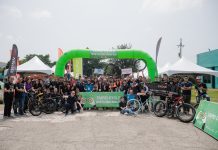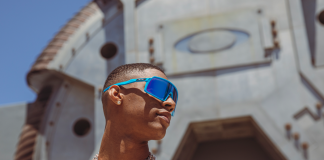TIMING THE RACE
 If it’s racing against time for the cyclists, it’s timing the race for Tissot. Mr. Alain walked us through a typical day at Tour de France.
If it’s racing against time for the cyclists, it’s timing the race for Tissot. Mr. Alain walked us through a typical day at Tour de France.
“There are two different formats in TdF. There’s a normal day format and there’s the time-trial format. TT is the challenging one, as it involves a different set of equipment.” The work that goes mostly unnoticed is driven by a sophisticated integrated system, keeping track of all the cyclists’ timing information.
“At the start of the stage race, we use photocells that go out at the starting gate. This starts the time. The equipment is connected from start to the finish.” This gives them the data as to what time the athlete left the gate, then they have the intermediates.
“Every single bicycle is equipped with a transponder. It’s a little chip attached on the front fork, which communicates with the antenna loops that are on the ground. There’s also the GPS sensor attached at the back of the saddle to take average speed information.”
Every time a bicycle passes, they would be able to identify the athlete and what time he passed the intermediate time check. All bikes are equipped with transponders, including the ones for switching.
“As a backup, we also have cameras filming and a race number attached to the bike.”
“The finish line area is the most interesting in the race, because this is where we officialize all the results. There’s a space dedicated for the officials.” While making the results official is a sight to see, Mr. Alain told us about the work they do at the finish line before the results are even made official. “The photo-finish cameras capture 2000 frames per second of the first 5mm of the finish line.” This allows them to dissect the finish and tell the difference especially for very close finishes between riders. Some can be too tight to determine with the naked eye.
“The entire system, the software and transponders, have all been renewed for TdF. From the computer screens, we also see how the red high-speed cameras at the finish take pictures.”
In case of power outage, results won’t be affected, as all computers have backup power supplies.
“Everything is backed up. It’s the most important thing. The athlete is. We have to make sure that we provide them with accurate times as soon as after they crossed the finish line.” They also have human spotters to verify the results.
Besides detailed timing, scoring and statistical within seconds, after data collection comes data dissemination. “As for live broadcast, we send data through fiber cables, which take the information and render the graphics. It’s just basically the output from the entire data management system.”
“We provide all these data, all those photo-finish pictures, to the organizers, media, TV and so on. As for safety and security features, these are provided by organizers. Data collection is a closed network. We need to secure the data collection.” In case anything happens within 3km before the finish line, they would take all the timing information needed by the officials to make a decision. Typically, at the end of the day, official results are taken from the photo-finish data collected.”
TRUST TISSOT
“Everything you see here has been tailor-made for cycling. Everything has been invented, produced and industrialized for cycling only. And, we’re not only talking about the hardware here, but also the software that manages all the data coming in.”
Mr. Alain added, “What differentiates Tissot from all others is that the production of this system is done in-house. We don’t buy pieces from outside, and this allows us to have an integrated system that we manage from A-Z.”
Tissot’s timekeeping experience in the history of bicycle racing has resulted to an extraordinary amount of trust from cycling governing bodies. Their story continues until time ends. Till then, you can count on Tissot.






























































































